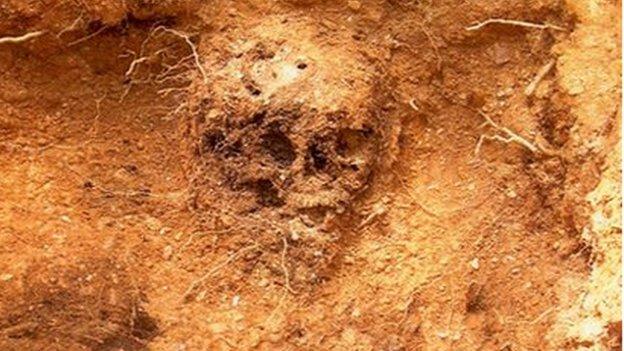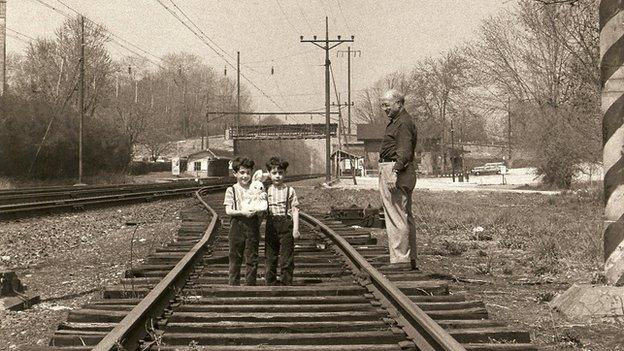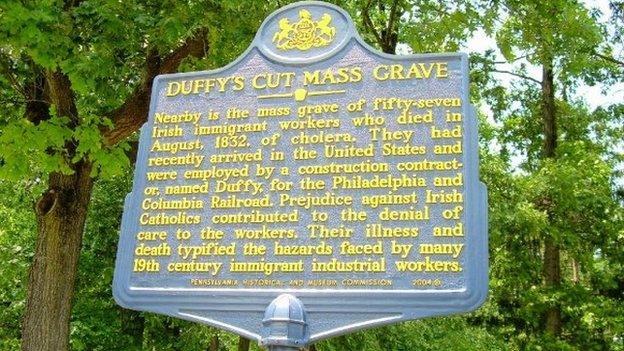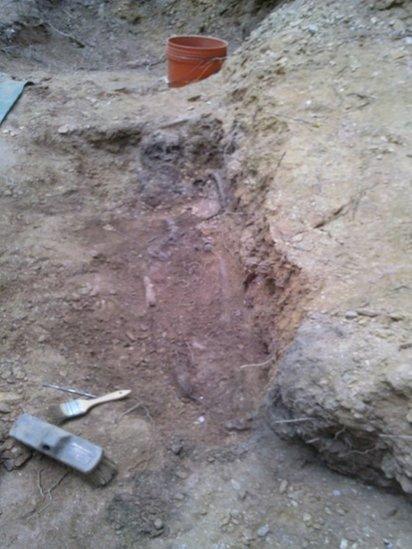Duffy's Cut: Irish emigrants' plight highlighted as murder victim returned home
- Published

Catherine Burns' skull as it was excavated in August 2010
A priest who will conduct the funeral service of a woman murdered in the US 183 years ago has said it brings into sharp focus the plight of Irish emigrants.
The remains of Catherine Burns, 29, will be returned to Clonoe, near Coalisland, County Tyrone, for reburial in the summer.
A widow, she left her native shores in 1832 with her father-in-law and many others from Tyrone. All hoped for a better life in the land of free.
However, within weeks of arriving, Catherine had disappeared - murdered while working for a US railroad.
She was among 57 Irish labourers hired to build a section of railway between Philadelphia and Columbia, a worksite that would become known as Duffy's Cut.

Catherine's name and that of her father-in-law John Burns on the John Stamp ship register that brought them to America
By the end of August 1832, all the workers were dead. Some perished due to a cholera outbreak, but most were murdered.
There are a number of theories as to why they were killed, including prejudice against Irish Catholics or a fear that they would spread cholera.
Many were buried in a mass grave and forgotten for more than a century. Catherine was buried nearby but the recent discovery of further fragments of her bones has lead to a move to have her remains returned home.
Fr Benny Fee, of St Patrick's Church, Clonoe, will preside over her funeral Mass on 19 July following her repatriation.
He said her story "touches our history with people leaving Ireland for America and their hopes and desires".
"Not everyone found its streets were paved with gold."

Frank and Bill Watson with their grandfather, Joseph Tripician, from Easter 1966, at Villanova Station, not far from Duffy's Cut
Emigration from Ireland began as early as 1603.
However, the period of greatest emigration began about 1780 and reached its peak from 1845 to 1855, when it is thought between one and two million people left Ireland because of the potato famine.
Fr Fee said: "There's a poignancy in it of this lovely girl who went to America hoping for a new home, a new life after her husband died, but in the words of the Christy Moore song about Duffy's Cut, she went 'into hell'.

The memorial cross at Duffy's Cut grave at West Laurel Hill Cemetery, Bala Cynwyd, Pennsylvania. Included are Frank and Bill Watson and their colleague Earl Schandelmeier
"She was one of the few females on the ship, that's how they were able to identify her.
"She was apparently bound and died from a blow with a sharp instrument."

A memorial stone to those who died at Duffy's Cut
Duffy's Cut and its story have been brought to light over the past 12 years, external by brothers Frank and William Watson, a Lutheran minister and a historian at Immaculata University.
They have led a team trying to uncover what happened to those 57 workers who hail from such places as Donegal, Tyrone and Derry.
Dr Frank Watson said they had used an old railroad file inherited from their grandfather to glean information.
After the mass grave was found in 2009, they sought to have the site excavated, remains identified and the cause of the emigrants' deaths determined.

The skeletal remains of Irish emigrant Catherine Burns
"We have now recovered six bodies and reburied five in West Lauer Hill cemetery in Bala Cynwyd, Pennsylvania in 2012, along with one in Ardara in Donegal in 2013 (John Ruddy, external)," he said.
"All of those recovered to this date were murdered by blunt force trauma, and one was both axed and shot in the head. None of the murdered show defensive wounds, indicating that they may have been tied up prior to being murdered.

A significant page from the Pennsylvania Railroad file on Duffy's Cut that the team used in their investigation
"On July 19 my brother Bill, Earl, and I will be travelling to Clonoe, Tyrone, to bury remains of the woman that were uncovered at Duffy's Cut named Catherine Burns (born around 1803) ."
In a further tragic twist to Catherine's story, no-one has been able to trace her family because they do not know her maiden name.
Fr Fee is also unaware of any of her relatives living in the area.
He said: "It is a cause for reflection that this lady is coming back to Tyrone. It will be a privilege to conduct the funeral.
"I want to give her the dignity and value in death that she did not have in life."